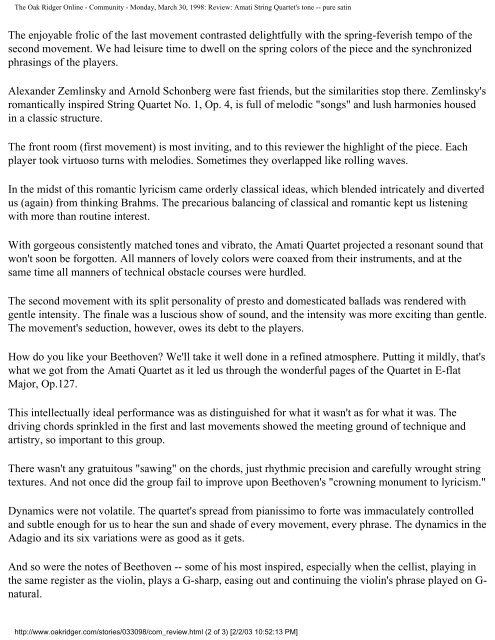Amati Quartet - Shupp Artists
Amati Quartet - Shupp Artists
Amati Quartet - Shupp Artists
- No tags were found...
You also want an ePaper? Increase the reach of your titles
YUMPU automatically turns print PDFs into web optimized ePapers that Google loves.
The Oak Ridger Online - Community - Monday, March 30, 1998: Review: <strong>Amati</strong> String <strong>Quartet</strong>'s tone -- pure satinThe enjoyable frolic of the last movement contrasted delightfully with the spring-feverish tempo of thesecond movement. We had leisure time to dwell on the spring colors of the piece and the synchronizedphrasings of the players.Alexander Zemlinsky and Arnold Schonberg were fast friends, but the similarities stop there. Zemlinsky'sromantically inspired String <strong>Quartet</strong> No. 1, Op. 4, is full of melodic "songs" and lush harmonies housedin a classic structure.The front room (first movement) is most inviting, and to this reviewer the highlight of the piece. Eachplayer took virtuoso turns with melodies. Sometimes they overlapped like rolling waves.In the midst of this romantic lyricism came orderly classical ideas, which blended intricately and divertedus (again) from thinking Brahms. The precarious balancing of classical and romantic kept us listeningwith more than routine interest.With gorgeous consistently matched tones and vibrato, the <strong>Amati</strong> <strong>Quartet</strong> projected a resonant sound thatwon't soon be forgotten. All manners of lovely colors were coaxed from their instruments, and at thesame time all manners of technical obstacle courses were hurdled.The second movement with its split personality of presto and domesticated ballads was rendered withgentle intensity. The finale was a luscious show of sound, and the intensity was more exciting than gentle.The movement's seduction, however, owes its debt to the players.How do you like your Beethoven? We'll take it well done in a refined atmosphere. Putting it mildly, that'swhat we got from the <strong>Amati</strong> <strong>Quartet</strong> as it led us through the wonderful pages of the <strong>Quartet</strong> in E-flatMajor, Op.127.This intellectually ideal performance was as distinguished for what it wasn't as for what it was. Thedriving chords sprinkled in the first and last movements showed the meeting ground of technique andartistry, so important to this group.There wasn't any gratuitous "sawing" on the chords, just rhythmic precision and carefully wrought stringtextures. And not once did the group fail to improve upon Beethoven's "crowning monument to lyricism."Dynamics were not volatile. The quartet's spread from pianissimo to forte was immaculately controlledand subtle enough for us to hear the sun and shade of every movement, every phrase. The dynamics in theAdagio and its six variations were as good as it gets.And so were the notes of Beethoven -- some of his most inspired, especially when the cellist, playing inthe same register as the violin, plays a G-sharp, easing out and continuing the violin's phrase played on G-natural.http://www.oakridger.com/stories/033098/com_review.html (2 of 3) [2/2/03 10:52:13 PM]


